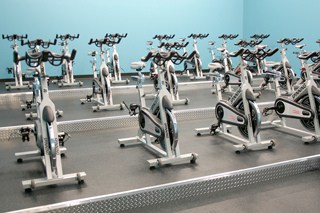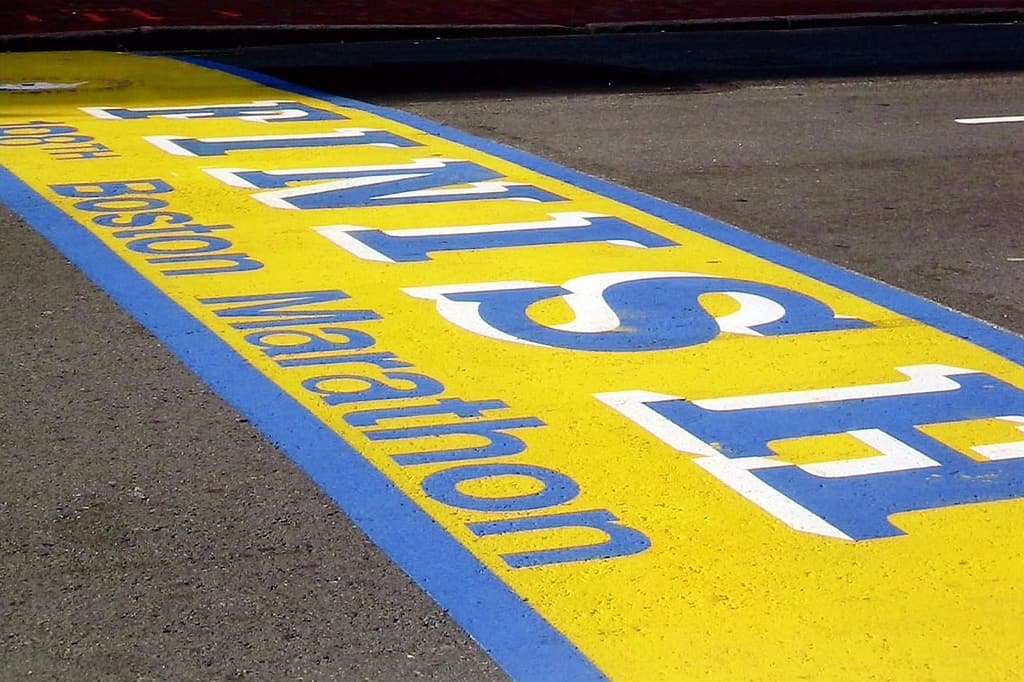My phone is not smart; my phone does not even “flip,” let alone “slide.” I covet the iPad, but I don’t have one.
I am not an early adopter.
Not surprisingly, I didn’t start going to spin class until late in the game. I didn’t even know what spin class was until last year. For whatever reason, I thought spin was something like rhythmic gymnastics1 – perhaps “spinning” a ribbon around.
Soon after a marathon was behind me and a Chicago winter was ahead of me, however, I decided to look for a way to exercise indoors that didn’t involve running in place.2 It is then I discovered spin.3
For those of you who don’t know, peeking into a spin class entails seeing a room full of sweaty people pedaling away atop stationary bicycles while rocking out to pop music and listening to an instructor with way too much energy somehow still manage to yell orders like a Prussian drill sergeant. All while cycling at 120 RPM.
It’s pretty much awesome. It also has a striking number of parallels with the spiritual life.
That’s not to say that it’s easy to pray immediately after spin class (especially when I can’t get Rihanna out of my head), but I have relearned a lot about prayer through my experience atop an exercise bike. In honor of the greatest #11 of all time, Sparky Anderson (sorry Isiah, but what you did to the Knicks disqualifies you), here are the top 11 prayer lessons I’ve relearned by spinning:
-
A class – or community – is invaluable. Sure, I can exercise on my own, just as I can pray by myself. That being said, it’s knowing that I will see my spin “community” that gets me out of bed and over to the gym, and I work much harder to get through the shared pain I feel in a spin class than I would if I were to sit on a stationary bike alone in a room. Not only are the sacraments similarly communal, but being in a worshiping community pushes me to spend more time in prayer and go deeper in my own faith after seeing the example of others. The daily Mass crowd, especially at an urban parish over the noon hour, can be a ragtag group: professionals on their lunch break, street people, retired couples, and religious sisters (who despite not wearing a habit can be spotted as nuns a mile away). A spin class can be equally eclectic. I may not know the name of the person in the neighboring pew or the young woman on the bike next to me, and yet I love the community that forms and the sense that we’re in this physical and/or spiritual exercise together.
- A lot of shame is a bad thing; a little bit of shame can be a good thing. We know that a deep sense of shame can prevent us from exercising in public just as it can keep us from turning to the God who loves us and wants us close. A little bit of potential shame, however, can be productive. If I don’t show up at spin class, I know that Molly will tell me, “So, we missed you this morning.” And that gets me out the door. If I am not there for Mass in the community, my Jesuit brothers will notice. And, sometimes, that gets me out the door. It’s not that I’m doing these things simply because of others’ expectations, but that potential “so, we missed you” gives me a little extra motivation to show up at the places that I know are good for me.
- It’s important to push through to the very end. Sometimes there are so many parallels between the Spiritual Exercises and what my spin instructors are yelling out that I wonder if they’ve been reading them before class. Ignatius instructs those going through the Exercises to pray for an hour at a time and to make sure we spend the full hour in prayer. He even goes out of his way to note that “the enemy of our human nature” will tempt us to shorten the time we had set aside for prayer. It’s the same in spin. It is tempting to relax during the bit of silence between the end of one song and the start of another, but instructors push us to keep up the intensity of the workout and in so doing they keep us moving through the lulls to the very end.
- If it’s not on my schedule – and typically my morning schedule – then it doesn’t happen. My days are often gobbled up by various commitments, and as a quintessential morning person, my mind turns into a pumpkin after 10:00 PM. But I notice that if prayer and exercise are “non-negotiables,” if they’re part of my routine, then they almost always get done. As busy as I am, I know Kelly will kick my butt into shape on Monday morning and Rachel will spin me around on Friday if that cycling class is already in my schedule. One other note, I recently directed a “busy student retreat” at which students were committed to a daily one-on-one meeting with me because it was part of their schedule for the retreat. But making time for prayer, something they were expected to do, wasn’t built into the retreat schedule. I noticed that because prayer wasn’t built into their schedule like the daily conferences that it was extremely difficult for many of them to make the time to do the prayer they obviously wanted to do.
- Women dominate. Remember my experience Irish dancing? Spin – and all too often, service and prayer experiences – are the same. Girls have dominated every retreat and service project I have been a part of, while guys have been busy… playing Halo? With spin class, it’s not even close; often I’m the only dude in a room of women with freakishly good endurance.
- The imagination is an underutilized but greatly valuable tool. “Jena, are you sure you aren’t from Loyola, Spain?” “No, you’re from Skokie? Well I’m not convinced.” Just like Ignatius has taught many of us how “Ignatian contemplation” (imaginative prayer, in which we place ourselves in a Gospel scene) can greatly deepen one’s prayer life, my spin instructor Jena has taught me how to visualize while spinning. I’ve even started noticing how visualizing that I’m on a hill trying to catch another rider can push me to go faster – or at least help me temporarily forget about the fire burning through my quadriceps.
-
Transitions are the most difficult. The most painful part about being a Jesuit for me is investing in relationships and digging my roots into a place only to have those roots ripped out when I’m sent off on another new mission in a different location. Likewise for transitions in spin class. In spin transition the spin instructor asks us to cycle in and out of different seated and standing positions. Let me tell you, these are a bear, especially “transitions with sprints.” I always find these analogous to moving to a new place with little time to prepare or settle in, and physically they are awfully like a fiery place filled with wailing and gnashing of teeth.
- Things are done better with coffee. Not only is coffee wonderful in itself, but it helps me connect with God because it makes me far more alert in prayer. While some athletes refuse to drink it before a competition, it is actually a legal performance-enhancing drug and makes me fly up those imaginative hills in spin class.
- We are supported by a communion of saints. I tend to use the word “saint” pretty loosely. In addition to those recognized by the Church, people like Dorothy Day and Pedro Arrupe are saintly figures who can inspire, guide, and intercede for us. Perhaps the communion of pop singers that blast from the speakers during class could also analogously serve in a saintly role for spinners – even if some of their lyrics or personal lives may not always be so saintly.
- Going deeper requires that we allow ourselves to be vulnerable. I am a sweaty mess when exercising. (No, I’m serious – my old yoga instructor would joke with other Jesuits that she needed to put a moat of towels around my mat in order to protect the rest of the group from my sweat). Sometimes I find it particularly discouraging to look around the roomful of spinners and not see a drop of perspiration from anyone else. “I look ridiculous,” I think to myself. Still, looking ridiculous is at least a sign that I’m getting a great workout. Being honest with oneself and God and not running away – even from the sweaty messes of our lives – is likewise essential in the spiritual life. This is especially true because I can only pray as I am, not as I want to be or what others expect me to be.
- The first step is the most difficult. Some mornings, it can take a lot of willpower to get out of my bed and make the trek across campus to the gym, just as it can be difficult to put everything aside and “waste time” with God when I’m tired, my bed is warm, and I have a million other things to do. But both spin and prayer nourish me; they challenge me in ways I need to be challenged. They can also be deeply enjoyable. It may take a lot of effort to get to the bike and give that first push to the pedal, but, like prayer, once I’m there it flows.
Those walking by overhearing Katy Perry and Nicki Minaj blasting from our spin class may not see this as a place to learn much about the spiritual life. And, I’ll be honest, I rarely pray during spin class (apart from, “Please, God, not another sprint!”). Still, some of the activities in our lives that are ostensibly removed from all things spiritual actually can inform our understanding of the spiritual life, if only we have eyes to see and ears to hear.
— — — — —
- Is that still an Olympic sport? While I know these people are tremendous athletes, does it rub anyone else the wrong way that there is an Olympic sport that involves a ribbon? ↩
- Granted, I would be perfectly fine if it still involved a Party in the USA. (Tim, it warms my heart that Miley warms yours.) ↩
- Granted, I guess it’s really just biking in place. For whatever reason, that feels far less mind-numbing than running in place. ↩





